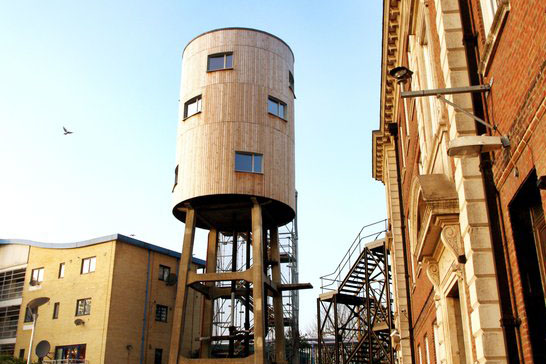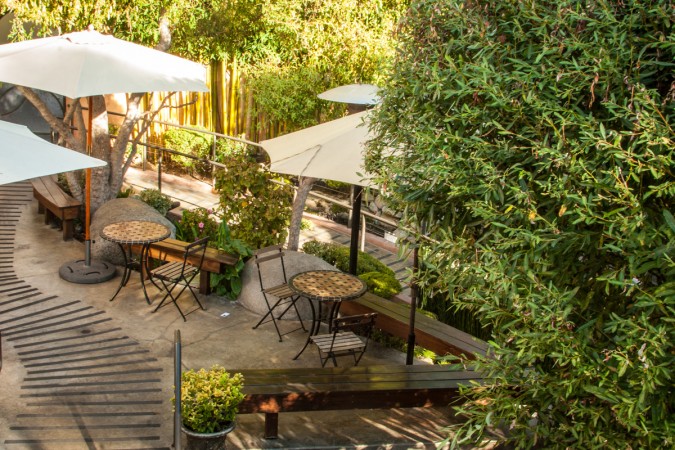Recycled structures and buildings and reclaimed spaces have been all over the news lately, from a West London water tower that was converted to a townhouse (now available for rent), to an artificial island floating on 250,000 recycled plastic bottles off the coast of Mexico. But a recycled building isn’t only one that is created out of an unusual structure or repurposed material; it can also be as simple as breathing new life into an abandoned space rather than tearing it down.
The City of Detroit has some 78,000 vacant structures that at least two local groups are working to help clear in a sustainable way. Recycle Detroit offers an interactive map on its website showing where valuable materials can be salvaged, while Reclaim Detroit advocates deconstruction rather than demolition, taking a building apart piece by piece so that the individual components are left in the best possible condition. But there’s also a third option: creative reuse.
Earlier this year, Detroit Public Schools hosted a conference to bring together property developers, real estate brokers, and investors to discuss the possibilities of some 80 vacant schools throughout the city. “Detroiters are eager to see these properties “re-purposed” to once again contribute to a healthy and safe living environment in neighborhoods throughout the city,” said Tahirih Ziegler, executive director of the Detroit Local Initiatives Support Corporation, in a press statement.
The school district has already turned one former high school into a 27-acre urban farm that will supply produce for the entire district’s student lunches. “We looked at the footprint of the area and tried to conceive of a plan to re-purpose one of our own buildings in a way that would benefit the city and neighborhood while serving our children by expanding access to fresh, healthy food,” said Betti Wiggins, executive director of the district’s Office of School Nutrition.
While Detroit’s supply of abandoned buildings likely unmatched anywhere else in the country, there are opportunities in most communities where creative reuse of an empty structure could turn an undesirable place into an attractive feature of a walkable urban neighborhood—adding new economic value too.

Public Interest Projects is an Asheville, NC-based company founded by Julian Price dedicated to revitalizing the city’s dilapidated downtown. For a decade, Price bought and renovated old buildings, leased the street-front spaces out to small businesses, and sometimes even financed new projects that promised to enliven the streets. When Price passed away in 2001, his successors realized that it wasn’t enough to finance their vision; they needed to get city officials to share it as well.
The group compared the economic contribution of two competing properties, a revived JCPenny building downtown now home to several shops, offices, and condos, and a brand new Walmart on the edge of town. They added up the property and sales tax of each property, and found that the Walmart, sitting on 34 acres, contributed $50,800 to the city’s coffers, while the old Penny’s building sitting on less than a quarter of an acre, contributed $330,000 per acre in property tax alone.
The National Trust for Historic Preservation recently completed a study in which it divided San Francisco, Seattle, and Washington DC into a grid of 200-by-200-meter squares to try and understand the relationship of old and new buildings to a city’s commercial viability. The study showed that in Seattle, there were 33% more jobs per commercial square foot in parts the city that had a variety of older, smaller buildings. In Washington DC, those types of neighborhoods had more non-chain businesses. It also showed that neighborhoods with a mix of small shops and restaurants had more foot traffic.
“For a long time, preservationists have been making the cultural argument that these places feed our soul, and they connect us to our past,” Stephanie Meeks, president and CEO of the National Trust told the Washington Post. “But this is the first time we’ve had empirical data to show that these places perform better economically and on many livability factors, as well.”
Oakland’s Temescal Alleys and Alley 49 (pictured above) turned a group of early 20th structures, many of which served as horse stalls for the area’s historic horse-drawn trolleys, into a charming pedestrian area of 18 locally-owned shops and artisan workspaces. Located a block away from Telegraph Ave., a growing business district in the North Oakland neighborhood of Temescal, the Alleys have become known for their First Fridays block party with live music and rotating art exhibits, as well as their holiday artisan fair, held in December. And they’ve been getting a lot of attention: Style.com called Temescal Alleys “Williamsburg-esque;” The New York Times called it an “outpost of cool;” and National Geographic wrote, “Shopping local should start in Temescal Alley.”

Epicurious Garden in Berkeley’s Gourmet Ghetto neighborhood is known for its gourmet take-out food, from sushi to homemade soups. What many people, aside from the long-time locals, don’t know is that the building was originally an early 20th century movie theatre and later a furniture salesroom. Developer Soheyl Modarressi says the project took 3.5 years to complete. The rebuilt space features a main dining hall, cooking school, and wine tasting room. A landscaped tranquility garden offers guests a quiet place in the middle of a busy urban landscape in which to enjoy their meal.
Looking for a property to revitalize? Philadelphia, PA-based photographer Matthew Christopher’s work features buildings in various states of decay and ripe for the repurposing. See a gallery of his work here.
Like this article? How about these: